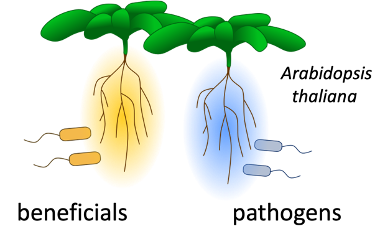Navigation auf uzh.ch
Navigation auf uzh.ch
To link exudation of specific compounds with the presence of specific microbes, exudation and microbiome profiles of phylogenetically distinct plants are analyzed. The hypothesis we are working with is that a core set of metabolites attracts microbes from the core microbiome that is associated with plant roots, and that more specialized microbes are attracted by compounds only produced by some plants (Figure 1_1).
To collect exudates and microbiomes, we use different experimental setups, ranging from sterile, hydroponic growths to nonsterile environments containing soil (Figure 1_2).
|
|
|
| Figure 1_1: generalist and specialist plant-microbe interactions | Figure 1_2: Growth systems for analysis of exudation and microbiomes |
Selected literature:
McLaughlin S., Zhalnina K., Kosina S., Northen T.R., Sasse J. (2023) The core metabolome and root exudation dynamics of three phylogenetically distinct plant species. Nature Communications 14: 1649, 1-13
https://doi.org/10.1038/s41467-023-37164-x
The involvement of transporters in exudation is rather unclear. We only know of a handful of transporters that are directly involved in exudation (Figure 2_1). Strikingly, each one of these transporters is needed for establishment of specific plant-microbe interactions.
The identification of novel transporters involved in exudation will allow us to study the effects of altered exudation of one/several metabolites on belowground plant-microbe interactions.

Figure 2_1: transporters involved in exudation (green) and potentially existing transporters for exuded compound classes (orange).
Selected literature:
Sasse J., Martinoia E., Northen T. (2018) Feed your Friends: Do Plant Exudates shape the Root Microbiome? Trends in Plant Science: 23:25-41. https://doi.org/10.1016/j.tplants.2017.09.003
Sasse J., Schlegel M., Borghi L., Ullrich F., Lee M., Liu G-W., Giner J-L., Kayser O., Bigler L., Martinoia E., and Kretzschmar T. (2016) Petunia hybrida PDR2 is Involved in Herbivore Defense by Controlling Steroidal Contents in Trichomes. Plant Cell Environment 39:2725-2739. https://doi.org/10.1111/pce.12828
It is yet rather unclear on how plants react to the presence of beneficial or pathogenic organisms on a metabolic level. The amount and timing of these responses is unclear, as well as if the response is rather local or systemic.
We make first steps investigating how metabolism of shoots, roots, and exudation changes in respect to beneficial and pathogenic microbes. We compare the responses we see in wild type lines to immune-compromised plants, which cannot recognize pathogenic signature molecules (effectors), and have a lower pathogen resistance (Figure 3_1).

Figure 3_1: Changes in exudation patterns upon inoculation with pathogenic or beneficial microbes